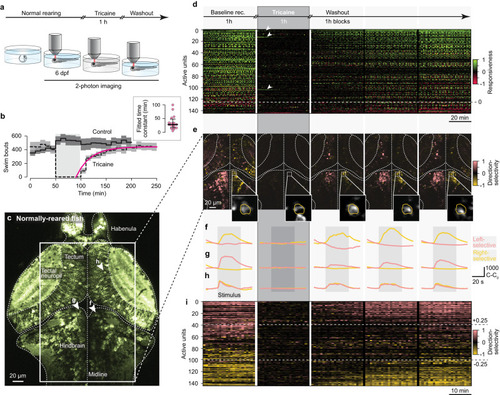|
Tricaine anesthesia reversibly silences neuronal activity. a Experimental paradigm: normally-reared fish are imaged at 6 dpf before, during, and after acute, one-hour tricaine anesthesia. b Effect of acute tricaine anesthesia on the number of bouts performed during OMR. Dashed black line, performance of fish that were anesthetized for one hour (in shaded region, n = 13); solid black line, control animals that were not anesthetized (n = 15). Lines, mean bout rate; bands, standard deviation; pink line, exponential fit of recovery of bout rate from anesthesia. Inset, time constants of recovery across animals (n = 16); horizontal bar, median; error bars, interquartile range. c Cross-section of imaged brain prior to tricaine administration, regions involved in visuo-motor processing are indicated. Box, cross-section analyzed in (d–i); arrowheads, individual units shown in f-h. Cross-sections of all imaged animals are shown in Supplemental Figure 12. d Top, schematic showing time-course of imaging experiment, each block contains 1 h of recording. The remainder of the figure is aligned to these imaging blocks. Bottom, responsiveness-index of units in tectum, pretectum, and hindbrain (n = 3 fish) across trials. Units above dashed line showed increased responsiveness to visual stimulation, units below showed decreased responsiveness. Arrowheads; most active units during anesthesia (traces shown in Supplemental Fig. 4a). e Leftward (salmon) and rightward (gold) direction-selectivity index computed for cross-section in box in c. Insets, rightward-selective example unit (yellow outline) that was imaged across the entire experiment (corresponding traces in f; each image normalized separately). f–h Averaged trials showing stimulus-evoked activity of rightward-selective (f), leftward-selective (g), and motion-selective (h) units. Note that visual responsiveness disappears during anesthesia and the same tuning re-emerges during washout. i Direction selectivity-index of units in tectum, pretectum, and hindbrain (n = 3 fish) across trials. Units above top dashed line, leftward-selective; units below bottom dashed line, rightward-selective. Note that relatively noisier signal during anesthesia is caused by unit-wise normalization used to compute direction-selectivity index (see Methods). Units in (d, e, i) consist of 1–5 neurons with the same response properties and thus represent small computational circuit blocks. Source data are provided as a Source Data file.
|

